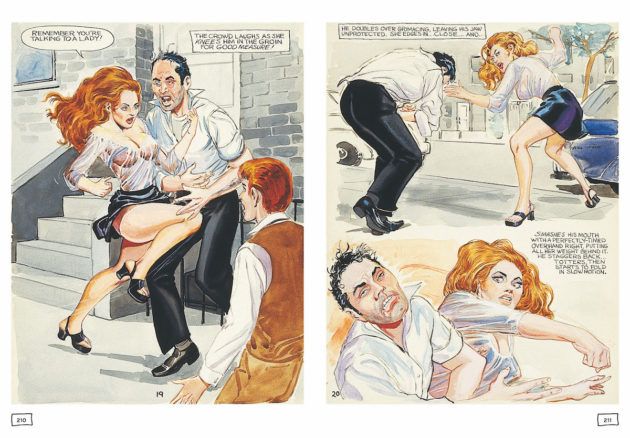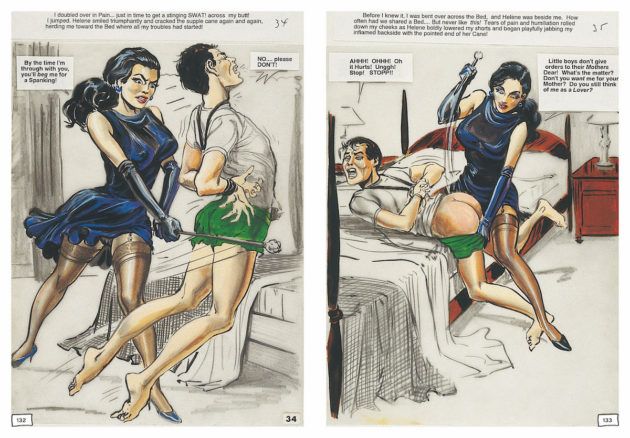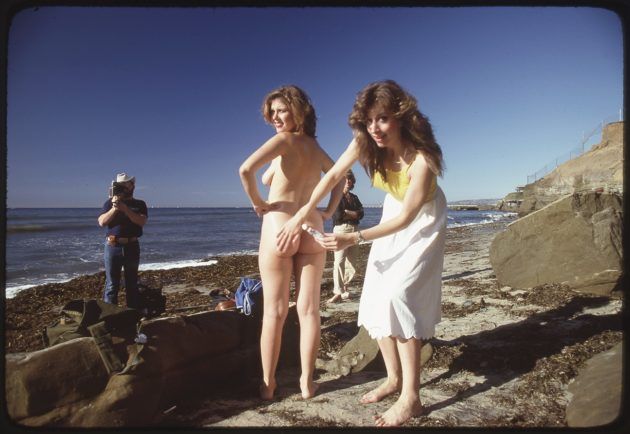From Gutenberg to Juggs: Celebrating Print’s 567th Birthday with Sexy Book Editor DIAN HANSON
|Eva Kelley
Just as Dian Hanson turned 18, censorship disappeared from the newsstands, allowing her to spend her birthday money on porn. “I wanted to see all the body parts,” she remembers fondly. Hanson’s fascination evolved into a career in print, co-founding the 1970s hardcore porn magazine Puritan and editing such journals as Juggs and Legshow. Today, her business card at the Cologne publishing powerhouse Taschen reads “Sexy Book Editor.”
The fact that everyone has a freaky side has been established. But with the noose of conservatism tightening around society, the call for strengthening the foundation of a sexually liberated order is warranted – and necessary. Hanson’s role in this plot is part-educator-part-seductress, spawning book series such as The Big Book of … [insert preferred sexual organ here] to the masses, while editing printed tributes for artists such as Eric Stanton and Elmer Batters, who helped fracture the facades of many past taboos.
032c’s Eva Kelley spoke with Hanson about all things Oedipal and political.

EVA KELLEY: Will “Sexy Books” save the book industry? Nobody’s going to download Araki onto their Kindle.
DIAN HANSON: The sexy book is the last remaining part of print pornography, I would say that. In the world of art books, we make more money with books on design, architecture, and celebrity fashion. That’s the popular stuff. People are still nervous about displaying sex. There was a review on The Big Book of Pussy on Amazon where a guy wrote: “Thank God it came in a plain brown wrapper. Who wants a 20 pound pussy book delivered by their postman?”
Honestly, I had hoped to work in pornographic magazines all my life. They just disappeared. There’s hardly anything left. Even Internet pornography, nobody is making money off of it anymore. People’s desire for it has made them pirate it, has made it free, has made it unprofitable. It’s driving down the quality and driving the people into impoverishment. Ren Hang was a fortunate find because he lived in a very repressive country where it’s still fresh and new to do something like that. There’s no good new photographers because they can’t make any money off of it. How do they pay a model? How do they pay for a location? And where is their outlet? Their outlet is nowhere.
And then you see these fetishes bubbling up into mainstream cinema. I was just reading about boob armor on female superheros and whether that was ever even a thing, historically.
It’s really hard to breathe, because they’re bustiers and formed so you’re compressing the ribs. Your boobs sit in there freely, but your ribs are being crunched. It’s not really conducive to superhero feats to have your chest compressed.

It’s something you see a lot in pornographic expressions. Like in Eric Stanton’s drawings. Tight confining corsets, super high heels. But at the same time, they are these strong, dominant women.
Traditionally, fetishwear makes women look formidable to men and cripples them in actuality. Women and many feminist writers would look at this and say, ‘Men are trying to cripple women, they are trying to control women.’ But this is a disconnect. In a case like this, a man sees a woman in pointy shoes and feminine armor and he feels intimidated. The clothes make her appear alien. And the more alien she is, the less he understands her, and the more power is invested. Also, he becomes vulnerable.
Does this stereotype of what is considered, in this case, a sexy dominant woman evolve at all, or are we just putting new brand names on the same old stagnated spiel?
Generally, what a person will respond to sexually is set in early childhood. It doesn’t evolve all that much. This is why you see people aroused by fashion that is out of date. Someone can still be turned on by seamed stockings, even though no one has worn them in forever. But mostly, you can trace the fetishistic clothing that a person will be attracted to in maturity back to around the age of five. For example, with a straight man, it’s whatever he saw women wearing when he was a little boy that had a special effect on him. Often, it’s something that his mother wore, like girdles and stockings. When I was working in magazines, I found our male audience eroticizing panty hose. It goes back to that time when they were visually aware as a child – around the age of five, in their oedipal phase when they fall in love with their mother as a romantic object. What we don’t think about is that the boy falls in love with her as a sexual object while also falling in love with her as a romantic object.
How does that express itself?
To us, it just looks cute – “I’m in love with mommy.” The love is connected to his sexuality. It’s all still developing, but we don’t realize that his sexuality is being set. While he’s exploring his mommy, he’s taking close notice of her clothing and odors – intriguing foot smells and under her clothing – which can lead them into liking the underwear, but it’s also how the foot fetishes come into being.

How does something like a leather fetish tie into that theory?
Leather is not a natural extension, but it comes about through its similarity to skin. If we go with Dr. John Money, the controversial sexologist of the twentieth century, he divided so-called paraphilias, which were perversions, up into different categories. Things that feel good on your fingertips, or smell and look intriguing. Leather has a distinctive, wonderful odor to it, but it also mimics flesh. It has a dual appeal, especially soft leather that is form-fitting. Dr. Money speculated that “the fetish” was set in when the child learned that his natural sexuality wasn’t acceptable. When a boy is around five years old, and his mother finds him playing with his penis, she will say something like: “That’s bad. You’re not allowed to do that.” If she goes further and makes it clear that the child is not lovable if it does that, the child will have to do something else to make its sexuality acceptable. A child has to be loved. And it has to be sexual. So it squirts out in these other areas. The child learns: “If I think about the vagina, that’s sexual and not acceptable. But if I think about the panties, which are affiliated with the vagina, that’s okay because that’s not exclusively sexual, and I can be loved.” Instead of wanting to put his penis in the vagina, he will wrap panties around his penis – a child’s logic. This usually doesn’t work in adulthood anymore.
Can all sexual preferences and fetishes be traced back to childhood experiences?
Pretty much. There’s no absolute proof on this because not enough money is put into it. Sex is at the center of everyone’s being, but there’s very little real research for it. Well, Alfred Kinsey started off the research – and the wonderful Magnus Hirschfeld. He was a Jewish physician, an advocate for sexual minorities, and led the fight to overturn Paragraph 175, which criminalized homosexuality back then. His sexual research institute was based in Berlin-Charlottenburg around 1900. Then the Nazis came in and burned all the books. The burning of the books in Berlin in 1933 included the ravaging of the Magnus Hirschfeld Institute to get rid of all of his texts on homosexuality, transgender, and fetish. But they don’t talk about it, do they? Because sexuality is suppressed.

If sex is so integral to our being, why are we so motivated to hide it?
Sex is unfortunately wrapped up in religion. We are taking a right-wing, conservative turn in the world. It’s back to the rise of religion. I’m largely talking from the perspective of an American and seeing the atrocities that are going on there now, but this is going on all over Europe. This rebellion against homosexual marriage and the transgender revolution. People are suddenly going, “Wait a minute, this is going too far and moving too fast.” They are frightened.
How does a fearful society express itself sexually?
The world is out of control. We are seeing the extreme repression of sex and gender roles on the one hand and the liberation on the other. Change used to come slow. Technology is moving things along faster, and this frightens those who can’t keep up with it. They want to retreat into things like belief in restrictive, punishing religions and governmental control because they want to feel safe. People are obsessed with feeling safe at a time when, in fact, there’s less crime than ever and less fatal disease. We are much safer than we were 50 years ago, but there’s more change and this scares people. We will have to deal with this fear and perhaps wait for a generation to die out.
Which generation?
People who are 70 and up, who are running the government, people who are just terrified and aren’t picking up on technology. The people who fill the churches. They are all going to have to die.

Credits
- Text: Eva Kelley
